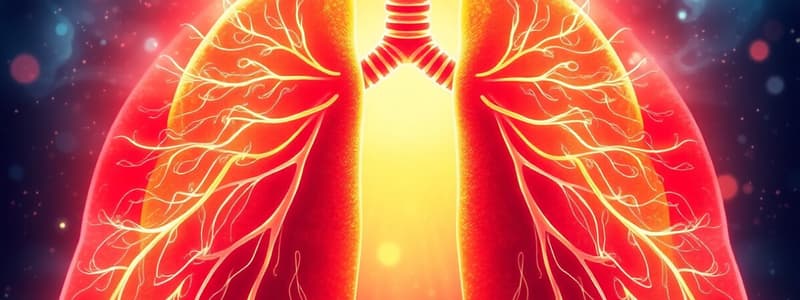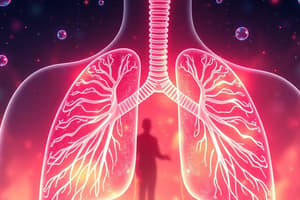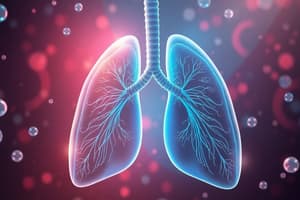Podcast
Questions and Answers
What is a potential side effect of using diuretics for hypertension management?
What is a potential side effect of using diuretics for hypertension management?
- Severe constipation
- Hyperkalemia
- Hypoglycemia
- Uric acid elevation (correct)
Which class of diuretics is known for having short-acting yet powerful effects?
Which class of diuretics is known for having short-acting yet powerful effects?
- Thiazide diuretics
- Loop diuretics (correct)
- Aldosterone antagonists
- Carbonic anhydrase inhibitors
Which of the following laxative classes is contraindicated in the presence of bowel obstruction?
Which of the following laxative classes is contraindicated in the presence of bowel obstruction?
- Surfactant laxatives
- Osmotics (correct)
- Lubricants
- Bulk-producing laxatives (correct)
What is a common reason for using aldosterone antagonists in hypertension management?
What is a common reason for using aldosterone antagonists in hypertension management?
Which side effect is most likely associated with thiazide diuretics?
Which side effect is most likely associated with thiazide diuretics?
Stimulant laxatives are primarily used to treat which of the following conditions?
Stimulant laxatives are primarily used to treat which of the following conditions?
What condition is a contraindication for the use of opioids as antidiarrheal agents?
What condition is a contraindication for the use of opioids as antidiarrheal agents?
Which of the following laxatives is indicated for chronic constipation and fecal impaction?
Which of the following laxatives is indicated for chronic constipation and fecal impaction?
What is a serious risk associated with the chronic use of absorbent drugs for diarrhea management?
What is a serious risk associated with the chronic use of absorbent drugs for diarrhea management?
What is the primary mechanism through which beta 2 receptor agonists cause bronchodilation?
What is the primary mechanism through which beta 2 receptor agonists cause bronchodilation?
Laxatives can cause which of the following electrolyte imbalances?
Laxatives can cause which of the following electrolyte imbalances?
Which of the following side effects is specifically associated with the use of spironolactone?
Which of the following side effects is specifically associated with the use of spironolactone?
Which of the following is NOT a side effect commonly associated with beta 2 receptor agonists?
Which of the following is NOT a side effect commonly associated with beta 2 receptor agonists?
What is a significant concern when administering inhaled corticosteroids at high doses to children?
What is a significant concern when administering inhaled corticosteroids at high doses to children?
What type of laxative is lactulose classified as?
What type of laxative is lactulose classified as?
What distinguishes Long Acting Muscarinic Antagonists (LAMA) from Short Acting Muscarinic Antagonists (SAMA)?
What distinguishes Long Acting Muscarinic Antagonists (LAMA) from Short Acting Muscarinic Antagonists (SAMA)?
Which diuretic class is specifically indicated for the management of hypertension and has longer-lasting effects with less diuresis?
Which diuretic class is specifically indicated for the management of hypertension and has longer-lasting effects with less diuresis?
In which condition is loperamide contraindicated?
In which condition is loperamide contraindicated?
What is the main contraindication for using montelukast?
What is the main contraindication for using montelukast?
What is the main action of chloride channel activators in treating chronic constipation?
What is the main action of chloride channel activators in treating chronic constipation?
Which pharmacokinetic feature is characteristic of methylxanthines?
Which pharmacokinetic feature is characteristic of methylxanthines?
What is a major concern when using diphenoxylate and difenoxin in children?
What is a major concern when using diphenoxylate and difenoxin in children?
Which drug used to treat chronic diarrhea in IBS is contraindicated in patients with a history of biliary disorders?
Which drug used to treat chronic diarrhea in IBS is contraindicated in patients with a history of biliary disorders?
Which type of antihistamines is known to cause sedation?
Which type of antihistamines is known to cause sedation?
What is a common side effect associated with inhaled anticholinergics?
What is a common side effect associated with inhaled anticholinergics?
Which of the following can lead to unexpected agitation in the pediatric population when used as an antiemetic?
Which of the following can lead to unexpected agitation in the pediatric population when used as an antiemetic?
What adverse effect is most associated with the prolonged use of phenothiazines?
What adverse effect is most associated with the prolonged use of phenothiazines?
Which of the following decongestants is known for causing burning or stinging sensations?
Which of the following decongestants is known for causing burning or stinging sensations?
Codeine is classified under which category of antitussives?
Codeine is classified under which category of antitussives?
What significant complication may occur from using 5-HT3 receptor antagonists?
What significant complication may occur from using 5-HT3 receptor antagonists?
Which leukotriene modifier is known to inhibit the formation of leukotrienes from arachidonic acid?
Which leukotriene modifier is known to inhibit the formation of leukotrienes from arachidonic acid?
Which cannabinoid is specifically used to treat N/V due to chemotherapy when other agents have failed?
Which cannabinoid is specifically used to treat N/V due to chemotherapy when other agents have failed?
What is the primary action of scopolamine as an antiemetic?
What is the primary action of scopolamine as an antiemetic?
What is the primary action of nasal corticosteroids?
What is the primary action of nasal corticosteroids?
What potential side effect does dextromethorphan share with codeine?
What potential side effect does dextromethorphan share with codeine?
Which adverse effect is particularly associated with the misuse of cannabinoids in patients?
Which adverse effect is particularly associated with the misuse of cannabinoids in patients?
What is the primary benefit of guaifenesin in respiratory therapy?
What is the primary benefit of guaifenesin in respiratory therapy?
What is a common adverse effect of 5-HT3 receptor antagonists?
What is a common adverse effect of 5-HT3 receptor antagonists?
Which class of antiemetics is contraindicated in patients with Parkinson’s disease?
Which class of antiemetics is contraindicated in patients with Parkinson’s disease?
What adverse effect is not common with short-term use of phenothiazines?
What adverse effect is not common with short-term use of phenothiazines?
Which of the following statements regarding antihistamines used in antiemetics is accurate?
Which of the following statements regarding antihistamines used in antiemetics is accurate?
What is a particular contraindication for the use of aprepitant in antiemetic therapy?
What is a particular contraindication for the use of aprepitant in antiemetic therapy?
What is a primary action of Histamine-2 Receptor Antagonists in the treatment of gastric conditions?
What is a primary action of Histamine-2 Receptor Antagonists in the treatment of gastric conditions?
Which adverse effect is most commonly associated with cimetidine?
Which adverse effect is most commonly associated with cimetidine?
What is a reported cognitive effect of H2RAs in the older population?
What is a reported cognitive effect of H2RAs in the older population?
What condition is primarily targeted for elimination in the treatment of Peptic Ulcer Disease (PUD)?
What condition is primarily targeted for elimination in the treatment of Peptic Ulcer Disease (PUD)?
Why is metoclopramide not used as monotherapy for GERD treatment?
Why is metoclopramide not used as monotherapy for GERD treatment?
What is the primary benefit of PPIs over H2RAs in treating gastric acid-related conditions?
What is the primary benefit of PPIs over H2RAs in treating gastric acid-related conditions?
What monitoring is recommended for patients on long-term H2RA therapy?
What monitoring is recommended for patients on long-term H2RA therapy?
What is one of the primary goals of GERD therapy?
What is one of the primary goals of GERD therapy?
Which of the following is a prokinetic agent mentioned in the context of GERD therapy?
Which of the following is a prokinetic agent mentioned in the context of GERD therapy?
Which of the following lifestyle modifications can help manage GERD symptoms?
Which of the following lifestyle modifications can help manage GERD symptoms?
Which aspect is important when considering the prescription of H2RAs to pregnant patients?
Which aspect is important when considering the prescription of H2RAs to pregnant patients?
What is the mechanism of action of proton pump inhibitors (PPIs) in treating GERD?
What is the mechanism of action of proton pump inhibitors (PPIs) in treating GERD?
What adverse effects can result from long-term use of H2RAs?
What adverse effects can result from long-term use of H2RAs?
Which adverse effect is commonly associated with the use of PPIs?
Which adverse effect is commonly associated with the use of PPIs?
What should be avoided when prescribing antacids for patients with renal failure?
What should be avoided when prescribing antacids for patients with renal failure?
Histamine-2 receptor antagonists (H2RAs) are generally considered second-line therapy for which of the following conditions?
Histamine-2 receptor antagonists (H2RAs) are generally considered second-line therapy for which of the following conditions?
Which nonpharmacologic therapy is recommended for patients with GERD?
Which nonpharmacologic therapy is recommended for patients with GERD?
What is a potential consequence of long-term PPI use?
What is a potential consequence of long-term PPI use?
What is one important consideration in the use of antacids as a treatment for GERD?
What is one important consideration in the use of antacids as a treatment for GERD?
Which statement about the use of prokinetic agents in GERD treatment is true?
Which statement about the use of prokinetic agents in GERD treatment is true?
What is a key action of antacids in the treatment of GERD?
What is a key action of antacids in the treatment of GERD?
Which of the following is NOT a consequence of prolonged PPI therapy?
Which of the following is NOT a consequence of prolonged PPI therapy?
In patients with GERD, which drug class is primarily used as first-line therapy for managing frequent symptoms?
In patients with GERD, which drug class is primarily used as first-line therapy for managing frequent symptoms?
What is a significant risk associated with combining medications with antacids?
What is a significant risk associated with combining medications with antacids?
Flashcards
What is the mechanism of action of beta 2 receptor agonists?
What is the mechanism of action of beta 2 receptor agonists?
Beta 2 receptor agonists stimulate relaxation of smooth muscle in the airway leading to bronchodilation, which is mediated through the cyclic AMP pathway. They also inhibit the release of inflammatory mediators from mast cells.
Differentiate between the different types of beta 2 receptor agonists based on their duration of action.
Differentiate between the different types of beta 2 receptor agonists based on their duration of action.
Short-acting beta agonists (SABAs) like albuterol provide 4-6 hours of bronchodilation and are typically used for quick relief of symptoms. Long-acting beta agonists (LABAs) like salmeterol offer 12 hours of bronchodilation and are prescribed for maintenance treatment. Ultra-long acting beta agonists (ULABAs) like indacaterol provide 24 hours of symptom relief.
How does theophylline, a methylxanthine, exert its bronchodilatory effect?
How does theophylline, a methylxanthine, exert its bronchodilatory effect?
Theophylline is a methylxanthine that inhibits phosphodiesterases, leading to increased cyclic AMP and subsequent bronchodilation and pulmonary vessel relaxation.
How do inhaled corticosteroids work to manage asthma?
How do inhaled corticosteroids work to manage asthma?
Signup and view all the flashcards
Explain the mechanisms of action of leukotriene modifiers, montelukast and zileuton.
Explain the mechanisms of action of leukotriene modifiers, montelukast and zileuton.
Signup and view all the flashcards
Compare and contrast first-generation and second-generation antihistamines.
Compare and contrast first-generation and second-generation antihistamines.
Signup and view all the flashcards
What is the mechanism of action of intranasal antihistamines, like azelastine?
What is the mechanism of action of intranasal antihistamines, like azelastine?
Signup and view all the flashcards
Explain the mechanism of action for decongestants like pseudoephedrine.
Explain the mechanism of action for decongestants like pseudoephedrine.
Signup and view all the flashcards
How do nonopioid antitussives like dextromethorphan and benzonatate suppress cough?
How do nonopioid antitussives like dextromethorphan and benzonatate suppress cough?
Signup and view all the flashcards
Describe the mechanism of action of guaifenesin, the only FDA-approved expectorant.
Describe the mechanism of action of guaifenesin, the only FDA-approved expectorant.
Signup and view all the flashcards
Explain how inhaled anticholinergics achieve bronchodilation.
Explain how inhaled anticholinergics achieve bronchodilation.
Signup and view all the flashcards
Distinguish between short-acting and long-acting muscarinic antagonists based on their duration of action.
Distinguish between short-acting and long-acting muscarinic antagonists based on their duration of action.
Signup and view all the flashcards
What are the primary side effects of beta 2 receptor agonists?
What are the primary side effects of beta 2 receptor agonists?
Signup and view all the flashcards
What are some potential side effects of inhaled corticosteroids?
What are some potential side effects of inhaled corticosteroids?
Signup and view all the flashcards
Loperamide
Loperamide
Signup and view all the flashcards
Eluxadoline
Eluxadoline
Signup and view all the flashcards
Alosetron
Alosetron
Signup and view all the flashcards
Phenothiazines
Phenothiazines
Signup and view all the flashcards
Dimenhydrinate
Dimenhydrinate
Signup and view all the flashcards
Dronabinol
Dronabinol
Signup and view all the flashcards
5-HT3 Receptor Antagonists
5-HT3 Receptor Antagonists
Signup and view all the flashcards
Scopolamine
Scopolamine
Signup and view all the flashcards
Substance P/Neurokinin 1 (NK1) Receptor Antagonist
Substance P/Neurokinin 1 (NK1) Receptor Antagonist
Signup and view all the flashcards
Trimethobenzamide
Trimethobenzamide
Signup and view all the flashcards
Anticholinergics
Anticholinergics
Signup and view all the flashcards
Toxic Megacolon
Toxic Megacolon
Signup and view all the flashcards
Antiemetics
Antiemetics
Signup and view all the flashcards
Antihistamines
Antihistamines
Signup and view all the flashcards
Diphenhydramine
Diphenhydramine
Signup and view all the flashcards
What are expectorants?
What are expectorants?
Signup and view all the flashcards
What are some side effects and precautions for expectorants?
What are some side effects and precautions for expectorants?
Signup and view all the flashcards
Explain the basic function of diuretics.
Explain the basic function of diuretics.
Signup and view all the flashcards
How do diuretics impact cardiac output and blood pressure?
How do diuretics impact cardiac output and blood pressure?
Signup and view all the flashcards
Name the main classes of diuretics.
Name the main classes of diuretics.
Signup and view all the flashcards
What are some significant side effects of diuretics?
What are some significant side effects of diuretics?
Signup and view all the flashcards
Describe the action of loop diuretics.
Describe the action of loop diuretics.
Signup and view all the flashcards
Explain the mechanism of thiazide diuretics.
Explain the mechanism of thiazide diuretics.
Signup and view all the flashcards
What is a distinctive characteristic of Thiazide diuretics?
What is a distinctive characteristic of Thiazide diuretics?
Signup and view all the flashcards
How do aldosterone antagonist diuretics work?
How do aldosterone antagonist diuretics work?
Signup and view all the flashcards
What are potential side effects associated with Aldosterone Antagonists?
What are potential side effects associated with Aldosterone Antagonists?
Signup and view all the flashcards
Explain the general role of laxatives in bowel healthcare.
Explain the general role of laxatives in bowel healthcare.
Signup and view all the flashcards
Describe the mechanism of stimulant laxatives.
Describe the mechanism of stimulant laxatives.
Signup and view all the flashcards
What is the working principle of osmotic laxatives?
What is the working principle of osmotic laxatives?
Signup and view all the flashcards
Explain the mechanism of bulk-forming laxatives.
Explain the mechanism of bulk-forming laxatives.
Signup and view all the flashcards
Goals of GERD Therapy
Goals of GERD Therapy
Signup and view all the flashcards
Nonpharmacologic Therapy for GERD: Food and Activity
Nonpharmacologic Therapy for GERD: Food and Activity
Signup and view all the flashcards
Nonpharmacologic Therapy for GERD: Positioning
Nonpharmacologic Therapy for GERD: Positioning
Signup and view all the flashcards
Nonpharmacologic Therapy for GERD: Weight Loss
Nonpharmacologic Therapy for GERD: Weight Loss
Signup and view all the flashcards
Nonpharmacologic Therapy for GERD: Smoking Cessation
Nonpharmacologic Therapy for GERD: Smoking Cessation
Signup and view all the flashcards
Antacids for GERD: Action
Antacids for GERD: Action
Signup and view all the flashcards
Antacids for GERD: Use
Antacids for GERD: Use
Signup and view all the flashcards
Antacids for GERD: Side Effects
Antacids for GERD: Side Effects
Signup and view all the flashcards
Proton Pump Inhibitors (PPIs) for GERD: Use
Proton Pump Inhibitors (PPIs) for GERD: Use
Signup and view all the flashcards
Proton Pump Inhibitors (PPIs) for GERD: Action
Proton Pump Inhibitors (PPIs) for GERD: Action
Signup and view all the flashcards
Proton Pump Inhibitors (PPIs) for GERD: Side Effects
Proton Pump Inhibitors (PPIs) for GERD: Side Effects
Signup and view all the flashcards
Histamine-2 Receptor Antagonists (H2RAs) for GERD: Use
Histamine-2 Receptor Antagonists (H2RAs) for GERD: Use
Signup and view all the flashcards
Drugs that Improve LES Tone for GERD: Action
Drugs that Improve LES Tone for GERD: Action
Signup and view all the flashcards
Prokinetic Agents for GERD: Action
Prokinetic Agents for GERD: Action
Signup and view all the flashcards
Cytoprotective Agents for GERD: Use
Cytoprotective Agents for GERD: Use
Signup and view all the flashcards
How do H2RAs work?
How do H2RAs work?
Signup and view all the flashcards
What is a side effect associated with cimetidine?
What is a side effect associated with cimetidine?
Signup and view all the flashcards
What is important to remember about H2RAs during pregnancy?
What is important to remember about H2RAs during pregnancy?
Signup and view all the flashcards
What are some considerations for using metoclopramide in GERD?
What are some considerations for using metoclopramide in GERD?
Signup and view all the flashcards
What is the mechanism of action of antacids in GERD?
What is the mechanism of action of antacids in GERD?
Signup and view all the flashcards
What is the primary goal in treating PUD?
What is the primary goal in treating PUD?
Signup and view all the flashcards
Why are PPIs preferred over H2RAs in treating PUD?
Why are PPIs preferred over H2RAs in treating PUD?
Signup and view all the flashcards
What is a potential adverse effect of long-term H2RA use?
What is a potential adverse effect of long-term H2RA use?
Signup and view all the flashcards
What is a key characteristic of H2RAs?
What is a key characteristic of H2RAs?
Signup and view all the flashcards
What are the specific uses and limitations of bethanechol?
What are the specific uses and limitations of bethanechol?
Signup and view all the flashcards
Study Notes
Beta 2 Receptor Agonists
- Bind to β2 smooth muscle cells in the airway, causing bronchodilation via cyclic AMP pathway
- Inhibit release of hypersensitivity mediators, especially from mast cells
- Some β1 receptor activity which causes side effects
- Absorbed from the bronchi, metabolized in the liver, and excreted in the urine. Multiple forms and delivery systems exist.
- Side effects include tachycardia and tremors. Precautions should be taken in patients with arrhythmias, cardiovascular disease, or hyperthyroidism.
Beta 2 Receptor Agonists Classifications
- Short Acting Beta Agonists (SABA): 4-6 hours
- Albuterol (Proair, Ventolin, Proventil)
- Levalbuterol (Xopenex)
- Pirbuterol (Maxair)
- Tirbutaline (Brethine)
- Long Acting Beta Agonists (LABA): 12 hours
- Salmeterol (Serevent)
- Formoterol (Foradil)
- Arformoterol (Brovana)
- Ultra Long Acting Beta Agonists (ULABA): 24 hours
- Indacaterol (Arcapta Neohaler)
- Olodaterol (Striverdi Respimat)
- Vilanterol (Breo Ellipta) (in combination with ICS only)
Inhaled Anticholinergics
- Block muscarinic cholinergic receptors by antagonizing acetylcholine, decreasing cyclic GMP formation, and reducing smooth muscle contractility in the lungs
- Poorly absorbed from the lungs and GI tract. 90% of the dose is excreted in feces, while 10% is metabolized by hydrolysis.
- Side effects include dry mouth, cough, and headache. Precautions include avoiding use in patients with urinary retention, benign prostatic hyperplasia (BPH), or closed-angle glaucoma.
Other Considerations
- Should not be used for acute bronchospasm unless combined with albuterol.
- Short and Long Acting Muscarinic Antagonists (SAMA/LAMA)
- Short Acting (SAMA): Ipratropium bromide (Atrovent), Ipratropium bromide/albuterol (Combivent), 4-6 hours
- Long Acting (LAMA)
- Tiotroprium bromide (Spiriva Handihaler/Respimat), 24 hours
- Aclidinium bromide (Tudorza Pressair), 12 hours
- Umeclidinium bromide (Incruse Ellipta), 24 hours
- Revefenacin (Yupelri), 24 hours (nebulized)
- Important considerations for all of the above drugs include possible interactions and side effects, and precautions for specific patient populations.
Studying That Suits You
Use AI to generate personalized quizzes and flashcards to suit your learning preferences.




